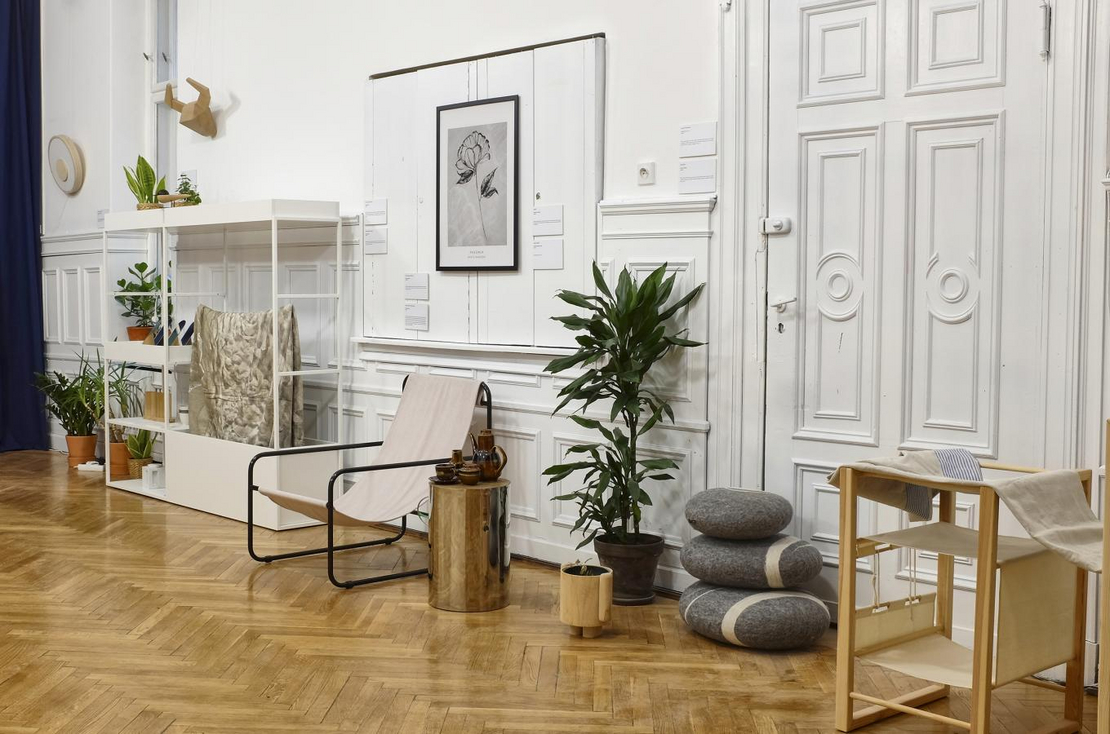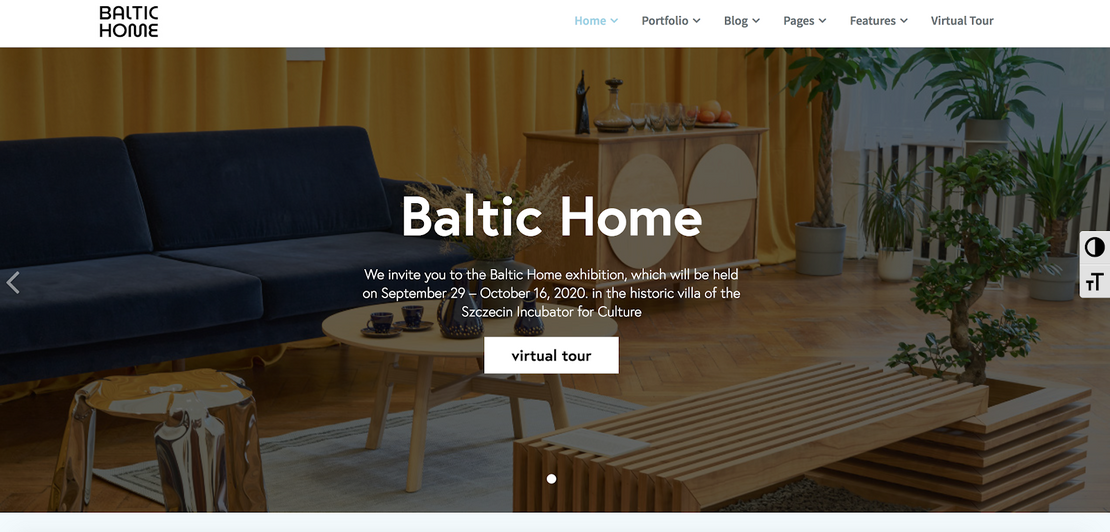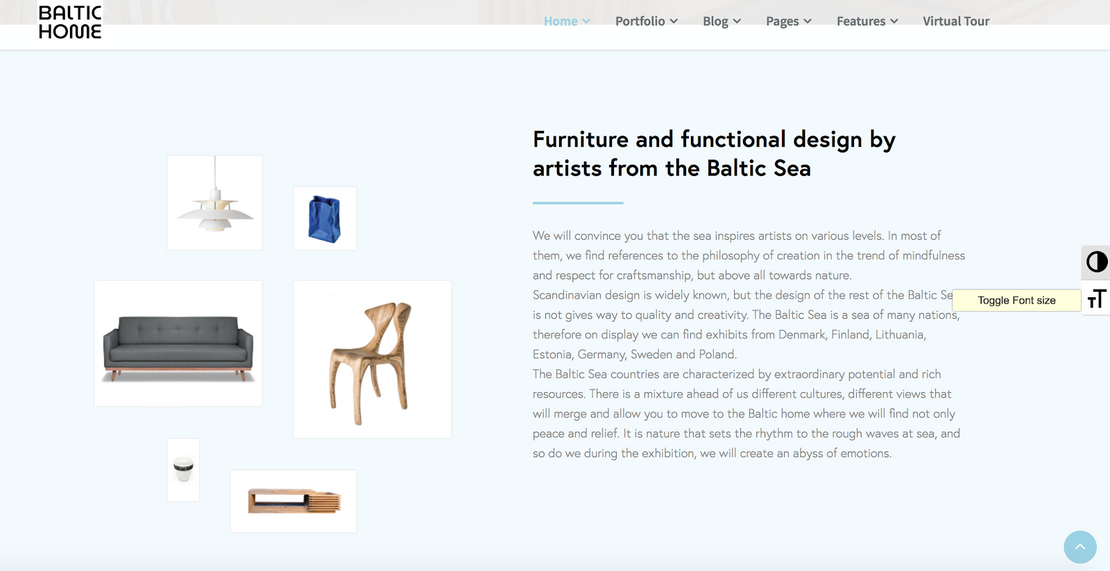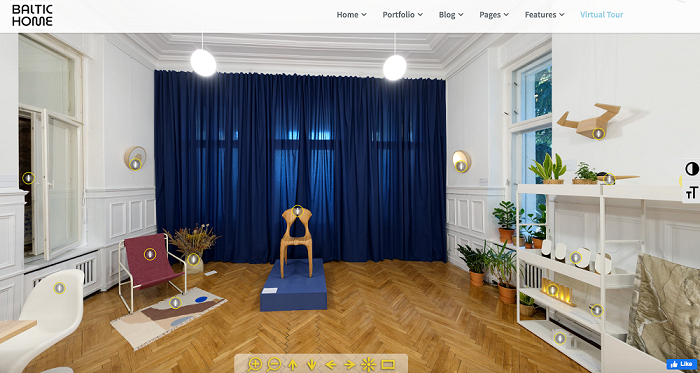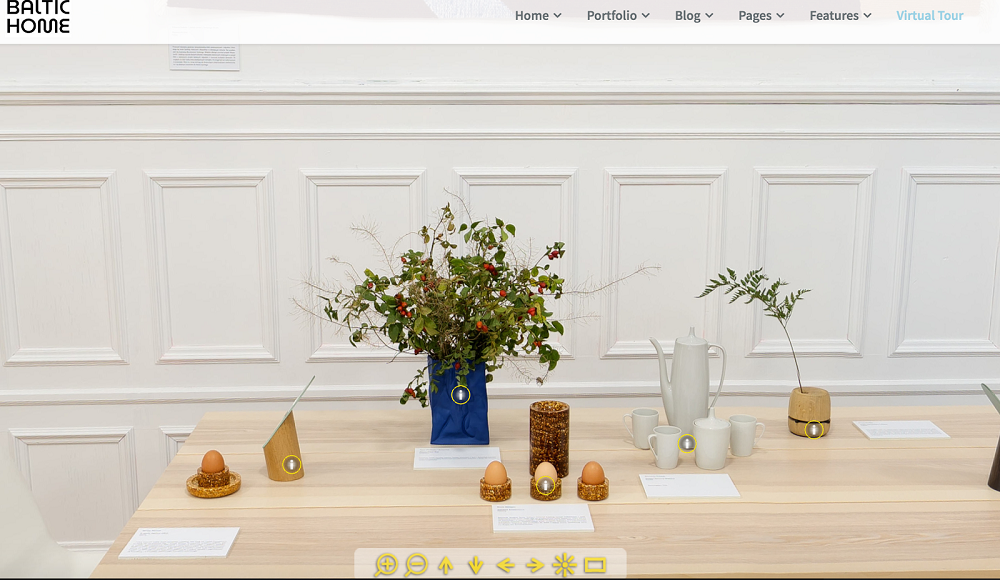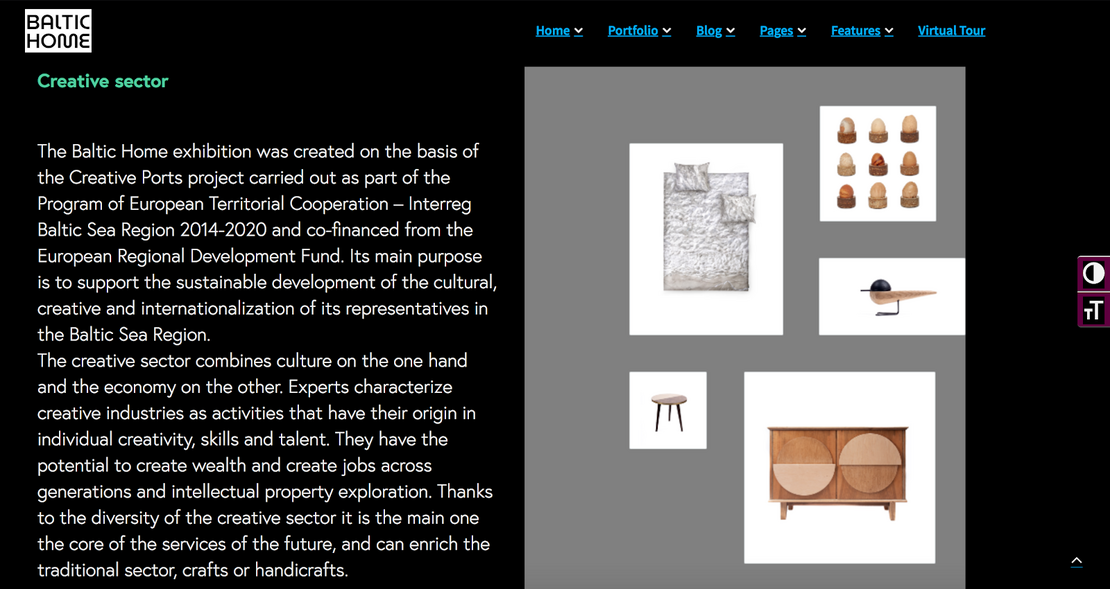VIRTUAL POP-UP EXHIBITION
Do you want to organize an online exhibition, and you are not sure how to do it? It's not difficult, get inspired by Baltic Home exhibition and start your adventure with online exhibitions!
Hosting Partner:Marshal’s Office of the Westpomeranian Region
Contact: Marta Ciesielska mciesielska[at]wzp.pl
The main aim of Baltic Home is to support intermediaries in building online experience of CCI sector and support them in building contacts, brand visibility and showcasing. Baltic Home learning module is build to help intermediaries in organizing 360 exhibition which is a core of the Baltic Home project.
The learning outcomes for the module are:
- understand how to organise a virtual 360 pop-up exhibition of furniture and other interior objects
- analyse the specific components of implementing the 360 approach when organising an exhibition
- evaluate the challenges and opportunities related to the implementation of the case study Baltic Home
- apply the gained knowledge to develop your own idea for building an online experience of CCI sector
- create new, smart and green experiences for CCI companies and customers
The learning module is based on the internationalisation tool – BALTIC HOME Virtual pop-up exhibition
The aim of the tool is:
• inspiration for new ideas, methods, technologies. One of the aims of the Baltic Home is to raise awareness among intermediaries about the diversity of design in the countries of the Baltic Sea and the simultaneous convergence of high-quality ideas and projects of cultural and creative industry (CCI).
• networks and contacts Strengthening the networks and collaboration between CCI intermediaries by introducing local creators from the Baltic Sea countries their creative contexts and opportunities for collaboration.
• brand visibility / Showcasing of products and services. Through the Baltic Home exhibition, the artists will gain more visibility, as does the design of a given country in general, which may not necessarily be known in other Baltic countries. The main outcome is a broader network that IM supporting the spread of Baltic design.
• capacity building / Peer learning In addition, IM learns about the potential and diversity of CCI from the Baltic Sea countries. Beneficial outcome is the growth of visibility of the international objects through online exhibition that reaches to a cross-border audience.
LEARNING MATERIALS
1.1. HOW TO ORGANISE A VIRTUAL EXHIBITION INTRODUCTION
With changing times, online virtual exhibitions are gaining popularity and audiences are also getting accustomed to this new trend.
Thanks to virtual tech advancements, also CCI companies can promote their products through virtual exhibition.
The audience attends virtual event right from their homes, on their computer screens, what became very important due to the travel restrictions placed around the world due to the coronavirus pandemic. They also save on the cost and time of commute and can participate by a few, simple clicks on their computer.
1.2 OUTLINE GOAL
Before you start you should outline the goals of your virtual exhibition. You might want to:
• Gain a following,
• Generate sales of CCI products
• Promote new CCI companies
• Deliver a message via your work
• Build a brand
• Build or increase brand awareness and respect to local/regional brands
• Create a buzz
Once you have identified your aims, refer to these at each stage of the planning process. This will allow you to streamline the planning process.
1.3 BUDGET
Virtual exhibitions are more budget-friendly than a traditional.
- With the small cost of logistics and rental fees you can create a more innovative and eco-friendly online version. Virtual exhibitions remain also an impactful experience for CCI companies and attendees/customers.
- As with every major event, virtual exhibition planning is limited to a budget, and the success of event dependents on how you utilize the available funds.
- In the case of traditional exhibitions the main budget-eaters are things like: venue, logistics, marketing, staff, technology and furniture etc.
- In case of virtual event you should think mostly about technology and marketing.
It needs to be easy for attendees to access your exhibition, however, it is equally important that the chosen technical solution encourages participants to stay longer on the website.
There are different ways to create an exhibition in the virtual network, e.g.:
- 360 photo with pins and web application,
- dedicated program for the implementation of exhibitions, e.g. omeka.org
- cooperation with service providers for the implementation of exhibitions, e.g. www.pageflow.io
- The choice of the implementation method depends mainly on time in which the exhibition is to be organized, the budget and the method of online presentation.
- Baltic Home exhibition was created in a 360° technique. A 360-degree camera is a camera with a visual field of the entire sphere or simply a camera with the ability to capture a 360-degree field of view in the horizontal plane. Viewing the photos or videos on a virtual reality headset can really make you feel like you were there. Each element of the exhibition was described, and an application for the exhibition was created.
- Regardless of which tool you choose, It is important to fully adapt to the digital medium and include things like links or videos in the content.
- In case of Baltic Home exhibision, when the exhibits were collected, a 360 photo was created, pins were added to the photo next to each exhibit so that you can focus on only one of the objects, get to know its specificity.
- To be publicly available, the photo must be placed on the server. A web application was created for the photo, which contained all information about the exhibition and individual objects. This application was placed at a dedicated address www.
1.5. TARGETING AN AUDIENCE
- You need to allocate a good proportion of your budget to promote the exhibition.
- It’s important to bear in mind the difference in approach when marketing to the attendees.
- Now you can use digital tool (such as social media channels) to invite people to participate in the exhibition.
- Select exhibits that shows a spectrum of different skills and capabilities.
- Try and pick pieces that could complement each other in terms of colors, style or medium to tie the group of works together. Think about how visitors are likely to travel around the exhibition.
- When inviting exhibitors, remember to obtaining permission from them to exhibit the object and its digitization and dissemination online.
2.1. FRIENDLY INTERFACE
The functionalities of the website translate into adaptation to the needs of recipients. It is especially worth paying attention to. Not only the hosting service of the website where it is presented is important. Parking a website at a specific website address is the beginning. It is worth adjusting the functionality of the website to the needs of all potential users, also with disabilities.
Friendly interface - being a logical arrangement of the most important content on the website. The key element is the so-called "Virutal tour", which is easily accessible from the start page as well as from the main menu. The website should have subpages, subheadings and footers. All this means that the user intuitively knows where the individual elements are located after a short time on the website, and the entire information structure is organized.
Font and its size - in the case of visually impaired people, one of the key solutions in terms of accessibility is the size and legibility of the font used. By convention, the symbol responsible for the possibility of such adjustment can be an icon representing three letters "tT". An icon that can be clicked to change fonts could be located on the right side of the website.
Therefore, it is possible to adjust the font size to individual needs. Placing it in the central part of the page makes it easier to find and use. The choice of the font itself is also important. For people with visual difficulties - Serif font is very difficult to read. Therefore, the selected font should be characterized by simplicity, which translates into high legibility.
2.3. ZOOM IN / OUT
Zoom in / out - the virtual tour also should have the facilities of zooming in from 80% to 300%, which enables the visually impaired to see the exhibits in detail.
2.4. CONTRAST
Contrast - whether the content on the website will be legible is also influenced by the contrast. In the Internet environment, there are usually contrasting versions, such as black background + white text, which was used for example for the Baltic Home website.
As in the case of the font, the contrast should be changed according to generally accepted standards by clicking one element, placed in a visible place. This is could be a circle icon next to the font size icon.
2.5. POSSIBILITY TO OPERATE THE SITE WITH ONE KEY
Possibility to operate the site with one button - the facilities for users with mobility limitations should be designed in such a way that they have the freedom to navigate the site, even by using only one key - the home page is a "scrolling" page, so there is no need to move around between pages and using additional buttons.
3.1. MAINTAINING
Maintaining a website requires paying for some services, regardless of whether the website is:
- an ordinary company website,
- private website,
- blog,
- online shop,
- online exhibition
or any other unusual site.
To maintain a website, you need to pay for services such as:
- hosting server,
- internet domain,
- or an SSL certificate.
You can also add the occasional cost of adjustments and updates to your site's software for maintenance.
When an internet user types a website address into the browser bar, this address shows the relevant website. This address is called a domain. You have to pay for the domain every year. Depending on its ending:
- e.g. com, eu, gallery, shop.
After entering the domain, the appropriate page should be displayed, like its photos, texts and videos.
In order for the Internet user to receive them, to see the website, another computer must send them these files. This computer is called a hosting server. Hosting also pays off once a year.
An undoubted cost is the realization of the photo in the 360-degree technique. This photo can be a one-off cost. It can also be assumed that the report of such a photo will be repeated, for example:
- update the exhibits, add something to the exhibition, modify its subject.



